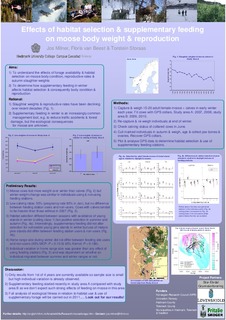Effects of habitat selection & supplementary feeding on moose body weight & reproduction
Conference object
Permanent lenke
http://hdl.handle.net/11250/134796Utgivelsesdato
2008-08Metadata
Vis full innførselSammendrag
The effects of forage availability, winter supplementary feeding and habitat selection on moose body condition, reproductive rates and autumn slaughter weights are being studied in two locations in south-east Norway. GPS collared moose cows and their calves have been weighed and monitored in 2 years in the first study area and are currently being followed in the second study area. Preliminary results suggest that moose cows lose proportionally more weight over winter than calves and winter weight loss is lower in individuals using feeding stations, but only significantly so in the study area with a longer history of feeding and more severe winters. In the less snowy study area, cows using feeding stations only spent 30% of the winter within 500m of feeding stations and showed little difference in winter weight change or reproductive rate from individuals not using feeding stations. In the same study area, winter habitat selection differed slightly between users and non-users of feeding sites with users selecting less for spruce and deciduous stands. However, commercially important young pine stands were favoured by both groups of moose suggesting that supplementary feeding does not reduce forest damage. Moose using feeding sites concentrated space use around feeding stations, becoming central-place foragers. Data collection is on-going but we expect that the effects of supplementary feeding on habitat selection and ecological fitness will increase with the proportion of time spent at feeding stations, and hence be greater in severe winters and as the duration of the feeding programme increases.
Beskrivelse
Posteren ble presentert på 6th International Moose Symposium i Yakutsk, Russland 13-21 august 2008
